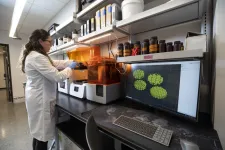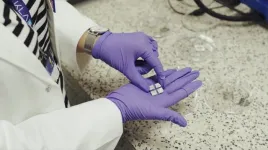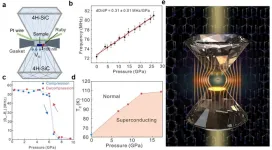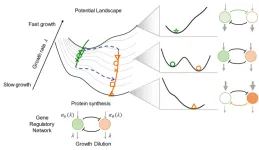(Press-News.org) Using artificial intelligence, researchers have discovered how to screen for genetic mutations in cancerous brain tumors in under 90 seconds — and possibly streamline the diagnosis and treatment of gliomas, a study suggests.
A team of neurosurgeons and engineers at Michigan Medicine, in collaboration with investigators from New York University, University of California, San Francisco and others, developed an AI-based diagnostic screening system called DeepGlioma that uses rapid imaging to analyze tumor specimens taken during an operation and detect genetic mutations more rapidly.
In a study of more than 150 patients with diffuse glioma, the most common and deadly primary brain tumor, the newly developed system identified mutations used by the World Health Organization to define molecular subgroups of the condition with an average accuracy over 90%. The results are published in Nature Medicine.
“This AI-based tool has the potential to improve the access and speed of diagnosis and care of patients with deadly brain tumors,” said lead author and creator of DeepGlioma Todd Hollon, M.D., a neurosurgeon at University of Michigan Health and assistant professor of neurosurgery at U-M Medical School.
Molecular classification is increasingly central to the diagnosis and treatment of gliomas, as the benefits and risks of surgery vary among brain tumor patients depending on their genetic makeup. In fact, patients with a specific type of diffuse glioma called astrocytomas can gain an average of five years with complete tumor removal compared to other diffuse glioma subtypes.
However, access to molecular testing for diffuse glioma is limited and not uniformly available at centers that treat patients with brain tumors. When it is available, Hollon says, the turnaround time for results can take days, even weeks.
“Barriers to molecular diagnosis can result in suboptimal care for patients with brain tumors, complicating surgical decision-making and selection of chemoradiation regimens,” Hollon said.
Prior to DeepGlioma, surgeons did not have a method to differentiate diffuse gliomas during surgery. An idea that started in 2019, the system combines deep neural networks with an optical imaging method known as stimulated Raman histology, which was also developed at U-M, to image brain tumor tissue in real time.
“DeepGlioma creates an avenue for accurate and more timely identification that would give providers a better chance to define treatments and predict patient prognosis,” Hollon said.
Even with optimal standard-of-care treatment, patients with diffuse glioma face limited treatment options. The median survival time for patients with malignant diffuse gliomas is only 18 months.
While the development of medications to treat the tumors is essential, fewer than 10% of patients with glioma are enrolled in clinical trials, which often limit participation by molecular subgroups. Researchers hope that DeepGlioma can be a catalyst for early trial enrollment.
“Progress in the treatment of the most deadly brain tumors has been limited in the past decades- in part because it has been hard to identify the patients who would benefit most from targeted therapies,” said senior author Daniel Orringer, M.D., an associate professor of neurosurgery and pathology at NYU Grossman School of Medicine, who developed stimulated Raman histology. “Rapid methods for molecular classification hold great promise for rethinking clinical trial design and bringing new therapies to patients.”
Additional authors include Cheng Jiang, Asadur Chowdury, Akhil Kondepudi, Arjun Adapa, Wajd Al-Holou, Jason Heth, Oren Sagher, Maria Castro, Sandra Camelo-Piragua, Honglak Lee, all of University of Michigan, Mustafa Nasir-Moin, John Golfinos, Matija Snuderl, all of New York University, Alexander Aabedi, Pedro Lowenstein, Mitchel Berger, Shawn Hervey-Jumper, all of University of California, San Francisco, Lisa Irina Wadiura, Georg Widhalm, both of Medical University Vienna, Volker Neuschmelting, David Reinecke, Niklas von Spreckelsen, all of University Hospital Cologne, and Christian Freudiger, Invenio Imaging, Inc.
This work was supported by the National Institutes of Health, Cook Family Brain Tumor Research Fund, the Mark Trauner Brain Research Fund, the Zenkel Family Foundation, Ian’s Friends Foundation and the UM Precision Health Investigators Awards grant program.
Paper Cited: “Artificial-intelligence-based molecular classification of diffuse gliomas using rapid, label-free optical imaging,” Nature Medicine. DOI: 10.1038/s41591-023-02252-4
END
Artificial intelligence predicts genetics of cancerous brain tumors in under 90 seconds
Researchers hope it will improve diagnosis and treatment, as well as clinical trial enrollment
2023-03-23
ELSE PRESS RELEASES FROM THIS DATE:
SLU research finds improved wastewater treatment could lead to significant reduction in greenhouse gas emissions
2023-03-23
ST. LOUIS – Research published in Environmental Research Letters has shown that methane emissions from urban areas are underestimated by a factor of three to four and that untreated wastewater may be a contributing factor.
The study, “Investigating high methane emissions from urban areas detected by TROPOMI and their association with untreated wastewater,” was led by Benjamin de Foy, Ph.D., professor of Earth and Atmospheric Sciences at Saint Louis University, and published online on ...
What really matters in multi-story building design?
2023-03-23
The impact of multi-storey building design considerations on embodied carbon emissions, cost, and operational energy has been revealed for the first time.
Using a computer model, researchers estimate that up to six gigatonnes of carbon could be saved by 2050 if new multi-storey buildings follow certain recommendations during the design process. All these recommendations, which could also save between 28 and 44% of annual heating and cooling costs, use technology that is currently available.
Construction and operation of buildings account for more than one-third ...
UTEP joins project to 3D print batteries from lunar and Martian soil
2023-03-23
EL PASO, Texas (March 23, 2023) – The University of Texas at El Paso has joined a project led by NASA to leverage 3D-printing processes with the aim of manufacturing rechargeable batteries using lunar and Martian regolith, which is the top layer of materials that covers the surface of the moon and Mars.
“UTEP is a national leader in additive manufacturing for space applications,” said Kenith Meissner, Ph.D., dean of the UTEP College of Engineering. “I congratulate the team of UTEP researchers involved in this important work. I am confident their work will add significant value ...
For stressed-out grad students, mindfulness makes big difference
2023-03-23
MADISON – While recent studies and polls indicate the nation is in the midst of a mental health crisis, the situation in academia is even more grim: Within the high-stress, high-pressure, often socially isolated world of advanced education, graduate students experience depression and anxiety at six times the rate of the general population.
Normalizing mindfulness practices within the graduate student experience may be an answer, according to a three-year study conducted by University of Wisconsin–Madison ...
Alzheimer's early detection through biomarkers -
2023-03-23
Scientists from Swansea University ‘s Institute for Innovative Materials, Processing and Numerical Technologies (IMPACT) and Japan have been awarded £1.3 million to develop a new “point of care testing” kit that can detect biomarkers for Alzheimer's Disease.
The project follows Dr Sanjiv Sharma’s ground-breaking work in this area and the development of the world’s first COVID-19 ‘smart patch’.
Compared to hypodermic single needles, a ‘smart patch’ consists of a collection of tiny needles - microneedles - created to break the skin barrier in a minimally invasive ...
Rates of autism climb to new highs in the U.S., with California setting record numbers
2023-03-23
New federal studies coauthored by autism experts at Rutgers found that more children have been diagnosed with autism than at any time since monitoring began more than two decades ago.
According to the U.S. Centers for Disease Control and Prevention (CDC), about 4 percent of 8-year-old boys and 1 percent of 8-year-old girls, have autism in the U.S. These estimates are the highest since the CDC’s Autism and Developmental Disabilities Monitoring (ADDM) Network was created in 2000.
Biennial studies from the ADDM Network, which analyzed ...
Study uncovers aspect of how muscular dystrophies progress
2023-03-23
A research study has shed new light on how congenital muscular dystrophies such as Walker-Warburg syndrome progress, bringing hope for better understanding, early diagnosis and treatments of these fatal disorders.
Published in March in the Journal of Biological Chemistry, the research was led by scientists in the lab of Vlad Panin, Ph.D., professor in the Department of Biochemistry and Biophysics in the Texas A&M College of Agriculture and Life Sciences. The study is titled “Protein tyrosine phosphatase 69D is a substrate of protein O-mannosyltransferases 1-2 that is required for the wiring of sensory axons in Drosophila.” ...
Researchers make breakthrough in high-pressure magnetic detection
2023-03-23
According to a study published in Nature Materials, a collaborative research team from the Hefei Institutes of Physical Science of the Chinese Academy of Sciences (CAS) and the University of Science and Technology of China has developed a research platform to study superconducting magnetic detection and magnetic phase transitions of hydrides under high pressure.
High-resolution in-situ magnetic measurement under high pressure has been a challenge. It has limited the progress of research on the Meissner effect of superconductivity and on magnetic phase transition behavior under high pressure. Using the optically detected ...
Cellular growth rate reshapes cell-fate-decision landscape
2023-03-23
Genes and the regulation relationships among them create complex networks that determine cell differentiation trajectories. However, we still cannot understand and predict the cell-fate-decision process using network topology in a bottom-up manner.
Recently, a research group led by Prof. FU Xiongfei from the Shenzhen Institute of Advanced Technology (SIAT) of the Chinese Academy of Sciences (CAS) has revealed how the global regulation factor, cellular growth rate, reshapes the cell-fate-decision landscape.
The ...
Where does your brain want to have lunch?
2023-03-23
New research published by investigators at Cedars-Sinai advances scientific understanding of how the brain weighs decisions involving what people like or value, such as choosing which book to read, which restaurant to pick for lunch—or even, which slot machine to play in a casino. Published today in the peer-reviewed journal Nature Human Behaviour, this study involved recording the activity of individual human neurons.
The study examined decisions called value-based choices, where there is ...
LAST 30 PRESS RELEASES:
Numbers in our sights affect how we perceive space
SIMJ announces global collaborative book project in commemoration of its 75th anniversary
Air pollution exposure and birth weight
Obstructive sleep apnea risk and mental health conditions among older adults
How talking slows eye movements behind the wheel
The Ceramic Society of Japan’s Oxoate Ceramics Research Association launches new international book project
Heart-brain connection: international study reveals the role of the vagus nerve in keeping the heart young
Researchers identify Rb1 as a predictive biomarker for a new therapeutic strategy in some breast cancers
Survey reveals ethical gaps slowing AI adoption in pediatric surgery
Stimulant ADHD medications work differently than thought
AI overestimates how smart people are, according to HSE economists
HSE researchers create genome-wide map of quadruplexes
Scientists boost cell "powerhouses" to burn more calories
Automatic label checking: The missing step in making reliable medical AI
Low daily alcohol intake linked to 50% heightened mouth cancer risk in India
American Meteorological Society announces Rick Spinrad as 2026 President-Elect
Biomass-based carbon capture spotlighted in newly released global climate webinar recording
Illuminating invisible nano pollutants: advanced bioimaging tracks the full journey of emerging nanoscale contaminants in living systems
How does age affect recovery from spinal cord injury?
Novel AI tool offers prognosis for patients with head and neck cancer
Fathers’ microplastic exposure tied to their children’s metabolic problems
Research validates laboratory model for studying high-grade serous ovarian cancer
SIR 2026 delivers transformative breakthroughs in minimally invasive medicine to improve patient care
Stem Cell Reports most downloaded papers of 2025 highlight the breadth and impact of stem cell research
Oxford-led study estimates NHS spends around 3% of its primary and secondary care budget on the health impacts of heat and cold in England
A researcher’s long quest leads to a smart composite breakthrough
Urban wild bees act as “microbial sensors” of city health.
New study finds where you live affects recovery after a hip fracture
Forecasting the impact of fully automated vehicle adoption on US road traffic injuries
Alcohol-related hospitalizations from 2016 to 2022
[Press-News.org] Artificial intelligence predicts genetics of cancerous brain tumors in under 90 secondsResearchers hope it will improve diagnosis and treatment, as well as clinical trial enrollment



